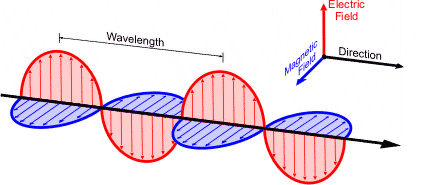
Electromagnetic waves are generated by oscillating electric charges or oscillating currents.
In a vacuum, electromagnetic waves propagate at the speed of light. They are characterized by alternating electric and magnetic fields and can travel long distances. Because EM waves span a wide range of frequencies and amplitudes, they can transmit various types of information through modulation and demodulation. Furthermore, EM waves carry energy that can be transferred via propagation, such as solar energy.
An electromagnetic wave is the propagation of an electromagnetic disturbance, representing the flow of energy from the electromagnetic field through space. It is not a mutual conversion between electric and magnetic field energy. Maxwell's equations show that the electric and magnetic field components of a propagating electromagnetic wave are in phase.
If you believe that EM wave propagation is an alternating process of a changing electric field generating a magnetic field, and a changing magnetic field generating an electric field, you might mistakenly think that the energy of the electric and magnetic fields convert into one another, making their components complementary. This view does not align with the traveling wave solution derived from Maxwell's wave equations.
However, the phenomenon of mutual conversion between electric and magnetic field energy does exist. This occurs in electromagnetic oscillations. In this case, the electric and magnetic field components are complementary and not in phase. This phenomenon corresponds to the standing wave solution of the wave equations derived from Maxwell's equations.
Excitation Methods for EM Waves
The principles for exciting electromagnetic waves can be categorized into electric field excitation and magnetic field excitation. Both methods involve adjusting electric and magnetic fields to initiate the physical process that generates EM waves.
- Electric Field Excitation Principle
This principle involves generating electromagnetic waves by varying voltage to regulate an electric field. It uses changes in the electric field as the source for the EM waves. The source is an oscillator in a circuit that alters the voltage over time, creating a time-varying electric field that radiates as an electromagnetic wave. The fundamental process involves an oscillating power source generating a signal, which causes the electric field to oscillate and propagate. Such circuits typically consist of an oscillator, a power amplifier, and a transmitting antenna to radiate a meaningful signal. - Magnetic Field Excitation Principle
This principle generates electromagnetic waves by utilizing changes in current. The physical process involves altering current flow—for instance, by switching a current on or off in a conductor. This change in current creates a time-varying magnetic field, which in turn radiates as an electromagnetic wave. While the physical mechanisms of electric and magnetic excitation are different, both result in the propagation of electromagnetic waves.
Sources of Electromagnetic Waves
The following are several primary methods of electromagnetic wave generation.
- Accelerating Charged Particles
Electromagnetic waves are produced when charged particles accelerate. This acceleration creates time-varying electric and magnetic fields in the surrounding space. These fields interact and propagate as an electromagnetic wave. For example, when electrons are accelerated in a particle accelerator, they generate high-energy electromagnetic waves such as X-rays and gamma rays. - Oscillating Circuits
An oscillating circuit, typically composed of an inductor and a capacitor (an LC circuit), generates electromagnetic waves as charge oscillates between the two components. These waves are commonly known as radio waves and have long wavelengths and low frequencies. Radio waves are widely used in communications, including radio broadcasting, mobile communication, and satellite communication. - Thermal Radiation
When an object is heated, its molecules and atoms vibrate, producing changing electric and magnetic fields. These fields form electromagnetic waves that radiate into the surrounding space. This process is known as thermal radiation and includes infrared, visible light, and ultraviolet waves. For example, the light and heat from the sun are produced by thermal radiation. - Astronomical Sources
Celestial bodies such as stars, planets, and galaxies also generate electromagnetic waves. Stars produce EM waves, including visible light, ultraviolet, X-rays, and gamma rays, primarily due to high temperatures from nuclear reactions. Planets and galaxies generate EM waves due to the motion of matter and gravitational interactions. Examples include the electromagnetic waves from Earth's magnetic field and ionosphere, as well as radio waves from the Milky Way galaxy.
 ALLPCB
ALLPCB







